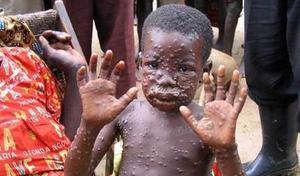Public healthVirus related to smallpox rising sharply in Africa
Thirty years after the eradication of smallpox, and the end of the mass smallpox vaccination campaign, rates of a related virus known as human monkeypox have increased dramatically in the rural Democratic Republic of Congo, with sporadic outbreaks in other African nations and even the United States

Human monkeypox cases rise in Africa // Source: healthspablog.org
In the winter of 1979, the world celebrated the end of smallpox, a highly contagious and often fatal viral infection estimated to have caused between 300 and 500 million deaths during the twentieth century.
The virus was eradicated through an aggressive worldwide vaccination campaign, which itself ended in 1980. With no virus, there was no longer a need for a vaccine. Now, researchers at UCLA say the elimination of the smallpox vaccine has allowed a related virus to thrive.
In the current online edition of Proceedings of the National Academy of Science, Anne Rimoin, an assistant professor of epidemiology at the UCLA School of Public Health, and colleagues report that thirty years after the mass smallpox vaccination campaign ceased, rates of a related virus known as human monkeypox have increased dramatically in the rural Democratic Republic of Congo, with sporadic outbreaks in other African nations and even the United States.
Until 1980, Rimoin said, the smallpox vaccine provided cross-protective immunity against monkeypox, a “zoonotic orthopoxvirus,” meaning it can be passed from animals to humans. Symptoms of monkeypox in humans include severe eruptions on the skin, fever, headaches, swollen lymph nodes, possible blindness and even death. There is no treatment.
“All you can do is provide supportive care,” Rimoin said. “There are no antibiotics. If you survive, the illness eventually runs its course.”
Once the smallpox vaccination program ended, new generations of people who were “vaccine naive” were exposed to the monkeypox virus the Democratic Republic of Congo over time, and the number of people who became infected gradually increased. But the increase went unnoticed because the nation has little or no health infrastructure and thus no way to monitor the spread of such diseases.
This is why, until her recent report, Rimoin said, monkeypox was thought to be very rare. Her research shows, however, that it has become very common.
Rimoin travels frequently to the Democratic Republic of Congo, where she has established a research site to study and track cross-species transmission of the disease. For this work, Rimoin and her colleagues conducted a population-based surveillance in nine health zones in the central region of the country between 2006 and 2007, gathering epidemiologic data and biological samples obtained from suspected cases. They then compared the current, cumulative incidences of infection with data gathered in similar regions from 1981 to 1986.
The results were startling, showing “a 20-fold increase in human monkeypox in the DRC since smallpox vaccinations were ended in 1980,” Rimoin said.
Rimoin noted that a monkeypox outbreak in the United States in 2003 had more to do with rodents than primates. That year, ninety-three people were infected throughout the Midwest, and the origin of the disease was later tracked to prairie dogs that had become infected and sold at a single pet store.
“The name ‘monkeypox’ is really a misnomer,” Rimoin said. “The disease was first identified in laboratory monkeys, thus providing it with its name. But in its natural state, it seems to infect squirrels and other rodents much more than primates.”
This is one of Rimoin’s chief concerns — that the virus will spread into the animal population more broadly. “The point is, it doesn’t take much for it to spread,” she said.
Because it is unlikely that smallpox vaccinations would be resumed, Rimoin is calling for improved health care education in the Democratic Republic of Congo and better disease surveillance. There is an urgent need to develop a strategy for reducing the risk of a wider spread of infections, she said.
In addition to Rimoin, multiple authors contributed to this study.
Funding for this work was provided by the Eunice Kennedy Shriver National Institute of Child Health and Human Development; the Global Network for Women’s and Children’s Health Research; the National Institute of Allergy and Infectious Disease; the National Institutes of Health; DHS; the Defense Threat Reduction Agency; the Global Viral Forecasting Initiative; and the Faucett Family Foundation.
